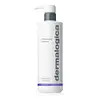What's inside
What's inside
 Key Ingredients
Key Ingredients

 Benefits
Benefits

 Concerns
Concerns

 Ingredients Side-by-side
Ingredients Side-by-side

Prunus Amygdalus Dulcis Oil
Skin ConditioningCaprylic/Capric Triglyceride
MaskingPEG-6 Caprylic/Capric Glycerides
EmulsifyingPEG-8 Beeswax
EmulsifyingCetearyl Alcohol
EmollientSorbitan Stearate
EmulsifyingSambucus Nigra Seed Oil
PEG-60 Almond Glycerides
EmulsifyingSilica
AbrasiveAvena Sativa Kernel Oil
Skin ConditioningTriticum Vulgare Germ Oil
EmollientButyrospermum Parkii Butter
Skin ConditioningCitrus Aurantium Dulcis Peel Wax
Skin ConditioningGlycerin
HumectantLecithin
EmollientBorago Officinalis Seed Oil
EmollientPhenoxyethanol
PreservativeCocos Nucifera Oil
MaskingAcacia Decurrens Flower Wax
EmollientRosa Multiflora Flower Wax
Skin ConditioningTocopherol
AntioxidantCocoyl Hydrolyzed Collagen
CleansingWater
Skin ConditioningSimmondsia Chinensis Seed Oil
EmollientPadina Pavonica Thallus Extract
Skin ConditioningPrunus Amygdalus Dulcis Oil, Caprylic/Capric Triglyceride, PEG-6 Caprylic/Capric Glycerides, PEG-8 Beeswax, Cetearyl Alcohol, Sorbitan Stearate, Sambucus Nigra Seed Oil, PEG-60 Almond Glycerides, Silica, Avena Sativa Kernel Oil, Triticum Vulgare Germ Oil, Butyrospermum Parkii Butter, Citrus Aurantium Dulcis Peel Wax, Glycerin, Lecithin, Borago Officinalis Seed Oil, Phenoxyethanol, Cocos Nucifera Oil, Acacia Decurrens Flower Wax, Rosa Multiflora Flower Wax, Tocopherol, Cocoyl Hydrolyzed Collagen, Water, Simmondsia Chinensis Seed Oil, Padina Pavonica Thallus Extract
Water
Skin ConditioningCetearyl Alcohol
EmollientBisabolol
MaskingZingiber Officinale Root Extract
MaskingLeuconostoc/Radish Root Ferment Filtrate
AntimicrobialGlycerin
HumectantAvena Sativa Kernel Extract
AbrasiveCucumis Sativus Fruit Extract
EmollientRubus Idaeus Fruit Extract
AstringentLavandula Angustifolia Flower Extract
CleansingSalix Alba Bark Extract
AstringentUsnea Barbata Extract
Butylene Glycol
HumectantPentylene Glycol
Skin ConditioningHydroxyphenyl Propamidobenzoic Acid
Skin ConditioningCitrus Medica Limonum Fruit Extract
Skin ConditioningFumaria Officinalis Flower/Leaf/Stem Extract
Skin ConditioningFumaric Acid
BufferingEchinacea Purpurea Extract
MoisturisingPanthenol
Skin ConditioningAcrylates/C10-30 Alkyl Acrylate Crosspolymer
Emulsion StabilisingCocamidopropyl Pg-Dimonium Chloride Phosphate
Disodium Lauryl Sulfosuccinate
CleansingCetrimonium Chloride
AntimicrobialAminomethyl Propanol
BufferingGlyceryl Caprylate
EmollientDisodium EDTA
Water, Cetearyl Alcohol, Bisabolol, Zingiber Officinale Root Extract, Leuconostoc/Radish Root Ferment Filtrate, Glycerin, Avena Sativa Kernel Extract, Cucumis Sativus Fruit Extract, Rubus Idaeus Fruit Extract, Lavandula Angustifolia Flower Extract, Salix Alba Bark Extract, Usnea Barbata Extract, Butylene Glycol, Pentylene Glycol, Hydroxyphenyl Propamidobenzoic Acid, Citrus Medica Limonum Fruit Extract, Fumaria Officinalis Flower/Leaf/Stem Extract, Fumaric Acid, Echinacea Purpurea Extract, Panthenol, Acrylates/C10-30 Alkyl Acrylate Crosspolymer, Cocamidopropyl Pg-Dimonium Chloride Phosphate, Disodium Lauryl Sulfosuccinate, Cetrimonium Chloride, Aminomethyl Propanol, Glyceryl Caprylate, Disodium EDTA
 Reviews
Reviews

Ingredients Explained
These ingredients are found in both products.
Ingredients higher up in an ingredient list are typically present in a larger amount.
Cetearyl alcohol is a mixture of two fatty alcohols: cetyl alcohol and stearyl alcohol. It is mainly used as an emulsifier. Emulsifiers help prevent the separation of oils and products. Due to its composition, it can also be used to thicken a product or help create foam.
Cetearyl alcohol is an emollient. Emollients help soothe and hydrate the skin by trapping moisture.
Studies show Cetearyl alcohol is non-toxic and non-irritating. The FDA allows products labeled "alcohol-free" to have fatty alcohols.
This ingredient is usually derived from plant oils such as palm, vegetable, or coconut oils. There is debate on whether this ingredient will cause acne.
Due to the fatty acid base, this ingredient may not be Malassezia folliculitis safe.
Learn more about Cetearyl AlcoholGlycerin is already naturally found in your skin. It helps moisturize and protect your skin.
A study from 2016 found glycerin to be more effective as a humectant than AHAs and hyaluronic acid.
As a humectant, it helps the skin stay hydrated by pulling moisture to your skin. The low molecular weight of glycerin allows it to pull moisture into the deeper layers of your skin.
Hydrated skin improves your skin barrier; Your skin barrier helps protect against irritants and bacteria.
Glycerin has also been found to have antimicrobial and antiviral properties. Due to these properties, glycerin is often used in wound and burn treatments.
In cosmetics, glycerin is usually derived from plants such as soybean or palm. However, it can also be sourced from animals, such as tallow or animal fat.
This ingredient is organic, colorless, odorless, and non-toxic.
Glycerin is the name for this ingredient in American English. British English uses Glycerol/Glycerine.
Learn more about GlycerinWater. It's the most common cosmetic ingredient of all. You'll usually see it at the top of ingredient lists, meaning that it makes up the largest part of the product.
So why is it so popular? Water most often acts as a solvent - this means that it helps dissolve other ingredients into the formulation.
You'll also recognize water as that liquid we all need to stay alive. If you see this, drink a glass of water. Stay hydrated!
Learn more about Water